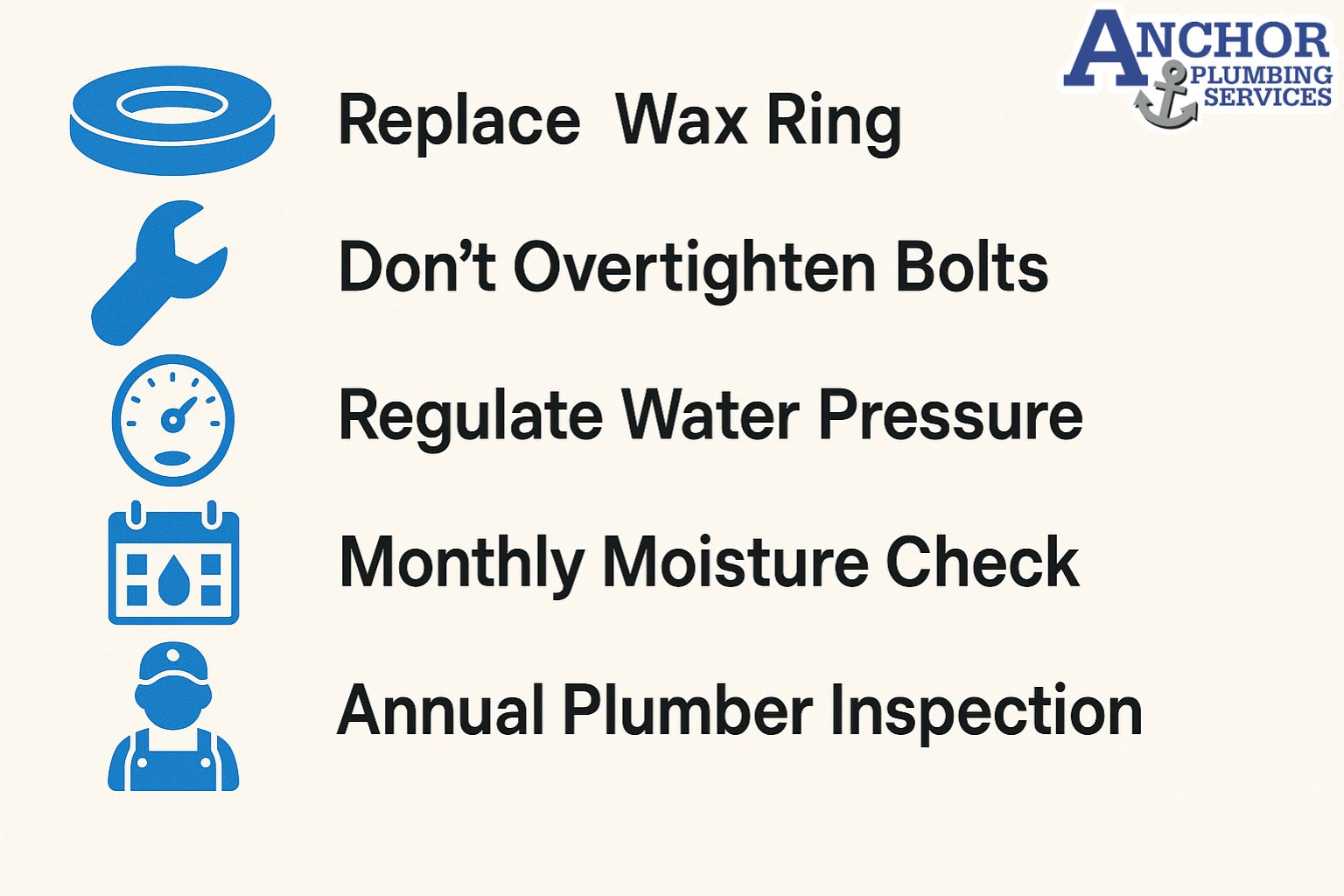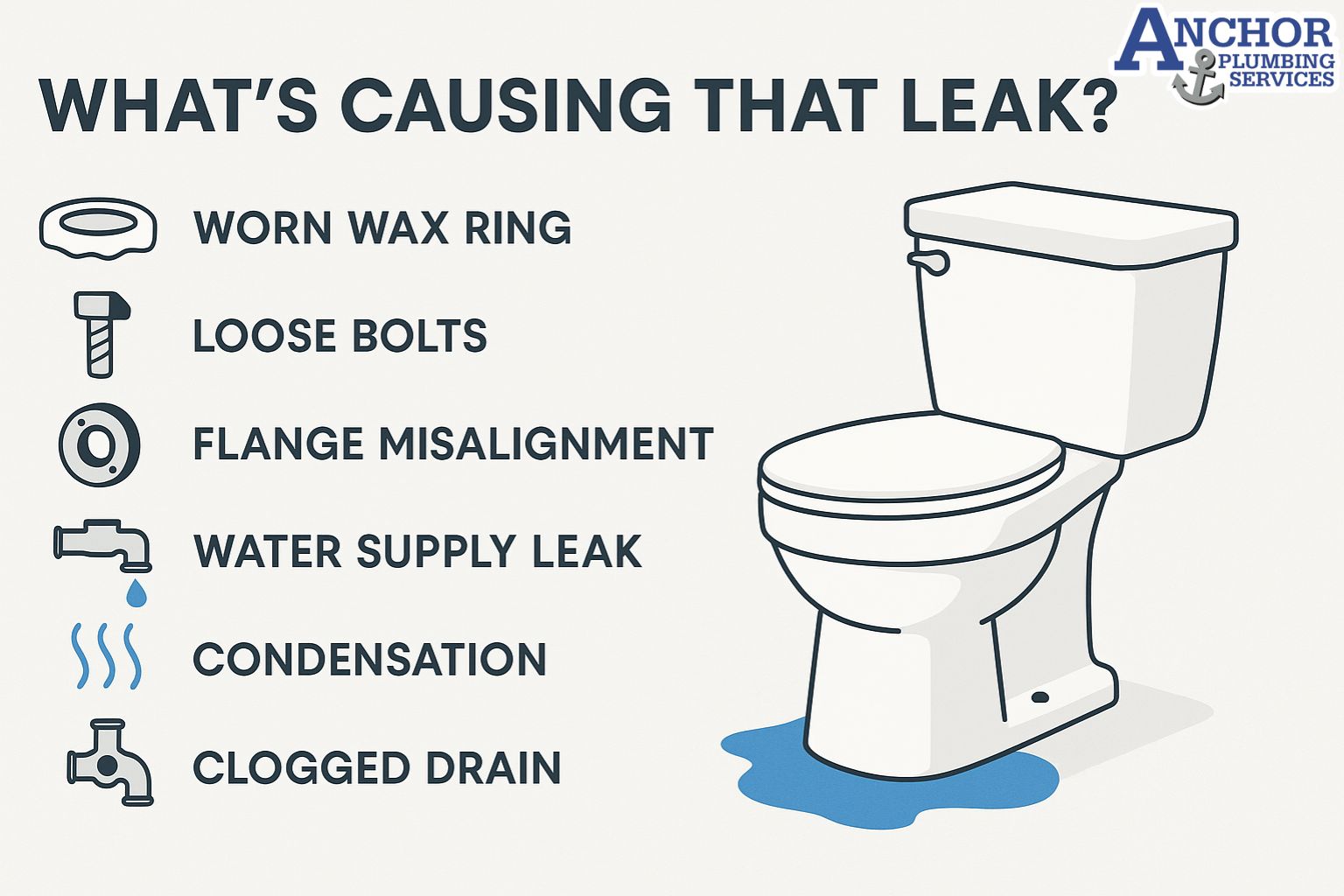A toilet leaking at the base means water is escaping where the toilet meets the floor. This happens when the wax ring seal between the toilet and the drain connection fails, allowing water to leak out during or after flushing. In some cases, loose bolts or a damaged toilet flange can break the watertight seal, leading to visible puddles around the base.
Water escaping from this area is not just a minor nuisance. It indicates a loss of proper sealing within your plumbing fixture connection. If ignored, the leak can damage flooring, subfloors, and even the ceiling below in multi-story homes. Identifying the issue quickly prevents more extensive plumbing repairs and protects your home from structural water damage.
What Does It Mean When Your Toilet Is Leaking at the Base?
A toilet base leak means the sealing ring or gasket beneath your toilet has deteriorated or shifted, breaking the seal that keeps wastewater inside the drain. Each flush forces pressurized water through this connection, so even a small crack in the seal allows water to escape onto the floor.
It is important to distinguish a true plumbing leak from simple condensation. Condensation, or “toilet sweating,” happens when warm, humid air meets a cold toilet tank or bowl, creating moisture on the exterior. In contrast, a real leak produces water that reappears after every flush and often carries a musty odor or visible discoloration near the floor.
Persistent moisture around the toilet base signals that water is entering from below, not forming on the surface. This type of leak can soak into subflooring, weaken structural materials, and promote mold growth over time. Early inspection and repair by a licensed plumber help ensure the leak is corrected before it causes major damage.
Common Causes — Why Is Your Toilet Leaking from the Base?

Most toilet base leaks occur because the seal between the toilet and the drain has failed or loosened over time. Each cause relates to how water travels during flushing or from nearby connections. Understanding the source helps prevent unnecessary repairs and protects your bathroom floor from long-term moisture damage.
- Worn or cracked wax ring: The most common cause of leaks is a deteriorated wax ring. Over time, wax rings compress and lose integrity, allowing water to escape during flushing. When this happens, you may notice small puddles around the toilet base after every use.
- Loose toilet bolts or flange misalignment: If the toilet moves slightly when touched, the floor bolts or the flange that holds the toilet may be loose or misaligned. Even minor movement can break the seal between the toilet and the drain pipe, letting water seep through the base.
- Condensation forming around the bowl: Condensation occurs when humid air meets a cool porcelain surface. The resulting water droplets can collect at the base and appear like a leak. However, condensation water does not reappear after each flush and feels cooler than typical leak water.
- Damaged toilet flange: A cracked or corroded flange can cause the toilet to sit unevenly on the floor, disrupting the seal with the drain. This damage often requires flange replacement to restore stability and prevent recurring leaks.
- Faulty water supply connection dripping toward the base: A loose or worn water supply line can drip down the tank and pool around the base. These leaks may appear similar to a wax ring failure but originate higher up near the tank’s inlet valve.
- Clogged drain causing water backup under the toilet: A partial drain blockage can push water back under the toilet during flushing. This creates pressure that forces water through weak seals or gaps around the flange, leading to pooling near the base.
How to Diagnose a Toilet Leaking at the Base

You can diagnose the source of a toilet base leak by observing how and when water appears. The goal is to confirm whether the problem comes from the seal, the tank, or nearby connections—without attempting repair before confirming the cause.
- Step 1: Dry the area completely: Use a towel to remove all visible moisture around the toilet base. This creates a clear baseline for identifying new water.
- Step 2: Flush the toilet and observe for new moisture: After drying the area, flush once and watch for water emerging near the base. Continuous or bubbling moisture typically points to a failed wax seal.
- Step 3: Check tank bolts and supply connections: Inspect the bolts connecting the tank to the bowl and the water supply line at the back of the toilet. Loose connections can cause leaks that drip downward and mimic base seal issues.
- Step 4: Inspect for floor softness or odor: Press gently around the floor near the toilet. Soft flooring or a musty smell suggests long-term moisture exposure, often from an ongoing leak beneath the toilet.
- Step 5: Use food coloring to trace the leak: Add a few drops of food coloring to the toilet tank and wait fifteen minutes without flushing. If colored water appears around the base, the wax seal has failed and needs replacement.
Accurate diagnosis ensures the correct repair method is chosen and prevents unnecessary part replacements or water damage to the subfloor.
How Can I Prevent Future Leaks from My Toilet Base?

You can prevent leaks by keeping your toilet properly sealed, maintained, and inspected at regular intervals. Small maintenance steps reduce the risk of moisture damage and prevent long-term plumbing problems.
- Replace the wax ring every 5 to 10 years: Wax rings compress over time and lose their ability to maintain a watertight seal. Replacing them every few years ensures continued protection against leaks during flushing.
- Avoid overtightening toilet bolts: Bolts that are too tight can crack the porcelain base or warp the flange. Tighten them just enough to hold the toilet securely without movement.
- Maintain stable water pressure: High water pressure can loosen fittings and weaken seals over time. Keep household pressure below 80 psi using a pressure regulator if necessary.
- Inspect for moisture monthly: Check the area around the toilet base for signs of dampness or musty odors. Early detection helps catch minor leaks before they damage flooring or subflooring.
- Schedule an annual plumber inspection: A licensed plumber can inspect the flange, bolts, and seal to ensure proper alignment and function. Annual maintenance helps prevent undetected leaks and prolongs the life of your toilet installation.
Regular inspection and tightening prevent base seal failure. Preventive care is the most effective way to avoid unexpected water damage and expensive repairs.
Frequently Asked Questions About Toilet Base Leaks
How to fix a toilet that is leaking at the base?
A plumber removes the toilet, replaces the worn wax ring, checks the flange, and reseals the base to stop water from escaping during flushing.
How often should I replace a toilet wax ring?
Replace the wax ring every 5 to 10 years or sooner if you notice leaks, movement, or a musty odor near the base.
Can a toilet leak from the base without flushing?
Yes. Continuous leaks can occur if water seeps from the tank or supply line and collects around the base even when not in use.
How to tell if a toilet flange needs replacement?
If the toilet rocks, bolts won’t stay tight, or water continues leaking after replacing the wax ring, the flange is likely cracked or misaligned.
Do I need a plumber for a leaking toilet?
Yes. A plumber ensures the leak source is correctly identified and that the new seal, flange, and fittings meet plumbing code requirements.
How long does it take to fix a leaking toilet base?
Most repairs take one to two hours depending on the extent of the damage and whether parts like the flange need replacement.
Is the toilet leaking from the bottom an emergency?
Yes. Water leaking near electrical outlets or flooring can cause structural damage and mold growth if not addressed quickly.
What’s the difference between a leaking toilet base and a leaking water supply line?
A base leak appears around the floor after flushing, while a supply line leak drips continuously from the tank connection above the base.
Can a leaking toilet base increase my water bill?
Yes. Even small leaks can waste significant water over time, leading to higher utility costs and potential subfloor damage.
What is the average cost to fix a leaking toilet base?
Repairs typically cost between 150 and 400 dollars depending on whether only the wax ring or the entire flange needs replacement.
What are the signs of a bad wax ring?
Persistent moisture, sewer odors, and water appearing after flushing usually mean the wax ring is cracked or compressed.
Can a loose toilet cause leaks at the base?
Yes. A shifting toilet breaks the wax seal, letting water escape through small gaps during flushing.
Is it safe to use a toilet that’s leaking from the base?
No. Using a leaking toilet can worsen water damage and promote mold growth. Turn off the water supply and call a plumber immediately.
Conclusion
A toilet leaking at the base is more than a minor plumbing issue. It indicates a failure in the seal that keeps wastewater contained and can quickly lead to subfloor rot, mold growth, and structural damage. Identifying early warning signs—such as damp floors, unpleasant odors, or loose fixtures—helps prevent costly repairs and keeps your bathroom safe.
Base leaks rarely fix themselves and often worsen with repeated use. Once water begins seeping beneath the toilet, it can compromise the wax ring, flange, and surrounding flooring. The longer moisture remains trapped under the fixture, the higher the risk of long-term water damage.
Water leaking from the base of your toilet requires professional attention. A leading top rated San Antonio plumbing company provides fast toilet leak repair, flange replacement, and sealing solutions across San Antonio. Anchor Plumbing Services licensed plumbers deliver dependable service, transparent pricing, and long-term results that restore your bathroom safely and efficiently.


